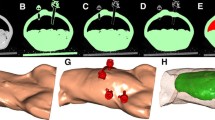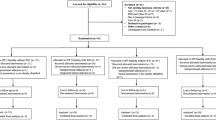Abstract
Background
Although postoperative intra-abdominal adhesion formation has been shown to be less with laparoscopic procedures than with open surgery, the extent of intraperitoneal adhesion formation after open and laparoscopic colon resection in patients with intra-abdominal infection remains unclear.
Methods
A standardized fecal inoculum was intraperitoneally applied in 72 rats to induce peritonitis. The rats were randomized into four groups. The three experimental groups underwent laparoscopic resection of the cecum with carbon dioxide (n=20) or helium (n=20) insufflation at a pressure of 8 mmHg, or conventional open cecum resection (n=20). In the control group, no further manipulations were performed after induction of the peritonitis (n=12). Blood samples were taken during the perioperative course to determine the plasma levels of tumor necrosis factor-alpha (TNF-α) and interleukin-10 (IL-10). The number of intraperitoneal adhesions and the bacterial species of peritoneal swabs were determined in each animal.
Results
The adhesions were increased in all operation groups as compared with the control group. The number of adhesions was sigificantly greater after conventional resection than after laparoscopic approaches (p<0.01). The overall adhesion score was significantly lower in the helium group (p<0.05) than in the two other operation groups. There was no difference between the laparotomy and carbon dioxide groups. Whereas postoperative TNF-α plasma levels were decreased, IL-10 levels were significantly greater in the helium group than in the other three groups.
Conclusions
Intraperitoneal infection is reducing the benefit of laparoscopic surgery regarding postoperative adhesions. Although laparoscopic resection showed an advantage in the number of adhesions with both gases, the total adhesion score was lowest in the helium group.
Similar content being viewed by others
References
Allendorf JDF, Bessler M, Whelan RL (1997) A murine model of laparoscopic-assisted intervention. Surg Endosc 11: 622–624 DOI: 10.1007/s004649900407
Ar’Rajab A, Davidson I, Sentementes J, Sikes P, Harris R, Mileski W (1995) Enhancement of peritoneal macrophages reduces postoperative peritoneal adhesion formation. J Surg Res 58: 307–312
Ar’Rajab A, Mileski W, Sentementes J, Sikes P, Harris R, Davidson I (1996) The role of neutrophils in peritoneal adhesion formation. J Surg Res 61: 143–146
Attwood SE, Hill AD, Murphy PG, Thornton J, Stephens RB (1992) A prospective randomized trial of laparoscopic versus open appendectomy. Surgery 112: 497–501
Beck DE (1997) The role of Seprafilm bioresorbable membrane in adhesion prevention. Eur J Surg 577: 49–55
Buckenmaier CC, Pusateri AE, Harris RA, Hetz SP (1999) Comparison of antiadhesive treatments using an objective rat model. Am Surg 65: 274–282
Burns JW, Colt MJ, Burgees LS, Skinner KC (1997) Preclinical evaluation of Seprafilm bioresorbable membrane. Eur J Surg 577: 40–48
de Virgilio C, Dubrow T, Sheppard BB, McDonald WD, Nelson RJ, Lesavoy MA, Robertson JM (1990) Fibrin glue inhibits intraabdominal adhesion formation. Arch Surg 125: 1378–1382
Dinsmore RC, Calton Jr WC (1999) Prevention of adhesions to polypropylene mesh in a rabbit model. Am Surg 65: 383–387
Elkins TE, Stowall TG, Warren J, Ling FW, Meyer NL (1987) A historic evaluation of peritoneal injury and repair: implications for adhesion formation. Obstet Gynecol 70: 225–228
Ellis H (1971) The cause and prevention of postoperative intraperitoneal adhesion. Surg Gynecol Obstet 133: 497–511
Fabri PJ, Ellison EC, Anderson ED, Kudsk KA (1983) High molecular weight dextran: effect on adhesion formation and peritonitis in rats. Surgery 94: 336–341
Fukasawa M, Girgis W, di Zerega GS (1991) Inhibition of postsurgical adhesions in a standardized rabbit model: II. intraperitoneal treatment with heparin. Int J Fertil 36: 296–301
Galili Y, Ben-Abraham R, Rabau M, Klausner J, Kluger Y (1998) Reduction of surgery-induced peritoneal adhesions by methylene blue. Am J Surg 175: 30–32
Gauwerky JFH, Mann J, Bastert G (1990) The effect of fibrin glue and peritoneal grafts in the prevention of intraperitoneal adhesions. Arch Gynecol Obstet 247: 161–166
Geis WP, Kim HC (1995) Use of laparoscopy in the diagnosis and treatment of patients with surgical abdominal sepsis. Surg Endosc 9: 178–182
Goldberg EP, Sheets JW, Habal MP (1980) Peritoneal adhesions: prevention with the use of hydrophilic polymer coating. Arch Surg 116: 776–780
Hansen JB, Smithers BM, Schache D, Wall DR, Miller BJ, Menzies BL (1996) Laparoscopic versus open appendectomy: a prospective randomized trial. World J Surg 20: 17–20
Henne-Bruns D, Höltig A, Teschund C, Kremer B (1990) Adhäsionsprophylaxe durch intraperitoneal applizierte Substanzen bei abdominellen Eingriffen. Langenbecks Arch Chir Suppl II (Kongreßbericht) 1: 1027–1030
Holtz G, Baker ER (1980) Inhibition of peritoneal adhesion formation after lysis with thirty-two percent Dextran 70. Fertil Steril 34: 394–395
Jacobi CA, Ordemann J, Böhm B, Zieren HU, Volk HD, Bauhofer A, Halle E, Müller JM (1998) Increased systemic inflammation after laparotomy vs laparoscopy in an animal model of peritonitis. Arch Surg 133: 258–262
Jacobi CA, Ordemann J, Böhm B, Zieren HU, Volk HD, Lorenz W, Halle E, Müller JM (1997) Does laparoscopy increase bacteraemia and endotoxaemia in a peritonitis model? Surg Endosc 11: 235–238 DOI: 10.1007/s004649900333
Jacobi CA, Ordemann J, Halle E, Volk HD, Müller JM (1999) The impact of laparoscopy with carbon dioxide versus helium on local and systemic inflammation in an animal model of peritonitis. J Laproendosc Surg 9: 305–312
Jorgensen JO, Lalak NJ, Hunt DR (1995) Is laparoscopy associated with a lower rate of postoperative adhesions than laparotomy? A comparative study in the rabbit. Aust N Z J Surg 65: 342–344
Kaidi AA, Gurchumelidze T, Nazzal M, Figert P, Vanterpool C, Silvia I (1995) Tumor necrosis factor-alpha: a marker for peritoneal adhesion formation. J Surg Res 58: 516–518
Kenward MA, Alcock SR, McKay IC (1984) Effect of hyperbaric oxyhelium gas on response of bacteria to antimicrobial agents in vitro. Antimicrob Agents Chemother 26: 833–836
Krähenbühl L, Schäfer M, Kuzinkovas V, Renzulli P, Baer HU, Büchler MW (1998) Experimental study of adhesion formation in open and laparoscopic fundoplication. Brit J Surg 85: 826–830
Lorenz W, Reimund KP, Weitzel F, Celik I, Kurnatowski M, Schneider C, Mannheim W, Heiske A, Neumann K, Sitter H (1994) Granulocyte colony-stimulating factor prophylaxis before operation protects against lethal consequences of postoperative peritonitis. Surgery 116: 925–934
Mais V, Ajossa S, Marongiu D, Peiretti RF, Guerriero S, Melis GB (1995) Reduction of adhesion reformation after laparoscopic endometriosis surgery: a randomized trial with an oxidized regenerated cellulose adsorbable barrier. Obstet Gynecol 86: 512–515
Marquis RE, Thom SR, Crookshank CA (1978) Interactions of helium, oxygen, and nitrous oxide affecting bacterial growth. Undersea Biomed Res 5: 189–198
Menzies D, Ellis H (1990) Intestinal obstruction from adhesions: how big is the problem. Ann Roy Coll Surg Engl 71: 60
Moore RG, Partin AW, Adams JB, Kavoussi LR (1995) Adhesion formation after transperitoneal nephrectomy: laparoscopic vs open approach. J Endourol 9: 277–280
Moreno Egea A, Aguayo JL, Zambudiob GZ, Parilla P (1995) Adhesion response to different forms of treating a peritoneal lesion: an experimental study in rats. Dig Surg 12: 334–337
O’Sullivan D, O’Riordain M, O’Connel RP, Dineen M, Brady MP (1991) Peritoneal adhesion after lysis: inhibition by polyethylene glykol 4000. Brit J Surg 78: 427–429
Reissman P, Bloom A, Roisman I, Groß D, Durst A (1993) Prevention of postlaparotomy adhesions using a foam composite of glycerine, propylene glykol, polyol, stearin, stearate, and silicon oil. Res Surg 5: 36–38
Reissman P, Teoh TA, Skinner K, Burns JW, Wexner SD (1996) Adhesion formation after laparoscopic anterior resection in a porcine model: a pilot study. Surg Laparosc Endosc 6: 136–139
Rodgers K, Cohn D, Hotovely A, Pines E, Diamond MP, diZerega GS (1998) Evaluation of polyethylene glycol/polylactic acid films in the prevention of adhesions in the rabbit adhesion formation and reformation sidewall models. Fertil Steril 69: 403–408
Tate JJ, Dawson JW, Chung SC, Lau WY, Li AK (1993) Laparoscopic versus open appendectomy: prospective randomised trial. Lancet 342: 633–637
Thompson JN, Whawell SA (1995) Pathogenesis and prevention of adhesion formation. Brit J Surg 82: 3–5
Tittel A, Schippers E, Anurov M, Titkova S, Öttinger A, Schumpelick V (1996) Geringeres Abdominaltrauma durch laparoskopische Chirurgie? Vergleich der Adhäsionsbildung und intestinalen Motilität nach laparoskopischen und konventionellen Operationen beim Hund. Zentralbl Chir 121: 329–334
Toh H, Torisu M, Shimura H, Kitsuki H, Uchiyama A, Itoh H, Ohsato K (1996) In vitro analysis of peritoneal adhesion in peritonitis. J Surg Res 61: 250–255
Tzianabos AO, Cisneros RL, Gershkovich J, Johnson J, Miller RJ, Burns JW, Onderdonk AB (1999) Effect of surgical adhesion reduction devices on the propagation of experimental intra-abdominal infection. Arch Surg 134: 1254–1259
Urbano D, Rossi M, De Simone P, Berloco P, Alfani D, Cortesini R (1994) Alternative laparoscopic management of perforated peptic ulcers. Surg Endosc 8: 1208–1211
Author information
Authors and Affiliations
Additional information
Online publication: 6 February 2001
Rights and permissions
About this article
Cite this article
Jacobi, C.A., Sterzel, A., Braumann, C. et al. The impact of conventional and laparoscopic colon resection (CO2 or helium) on intraperitoneal adhesion formation in a rat peritonitis model. Surg Endosc 15, 380–386 (2001). https://doi.org/10.1007/s004640000359
Received:
Accepted:
Issue Date:
DOI: https://doi.org/10.1007/s004640000359




